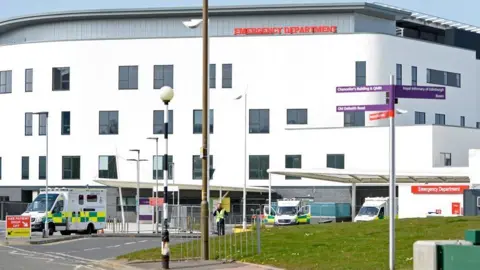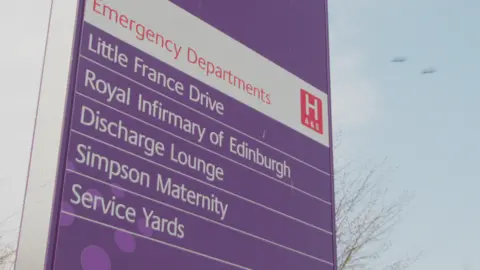'Serious concerns' raised about overcrowded A&E
 Getty Images
Getty ImagesOvercrowding at one of Scotland's busiest emergency departments created a fire safety risk, watchdogs have warned.
Healthcare Improvement Scotland (HIS) said it was "not assured" of fire safety at the Royal Infirmary of Edinburgh A&E department which at times operates at 300% of its capacity.
The watchdog found "multiple systemic failures" over two visits to the A&E.
NHS Lothian said a major improvement drive was already under way.
The health board said redesign work to improve patient safety and flow through the hospital would improve its performance.
The unannounced HIS inspection of the Royal Infirmary of Edinburgh took place in February when the hospital was operating at more than 100% capacity and facing the peak of its winter pressures.
It covered 13 wards, intensive care and the emergency department.
The HIS report noted the A&E had "extremely congested corridor areas with high numbers of patient trolleys" and staff shift logs showed that in the week prior to the inspection, the department was at times operating at more than 300% of its capacity, with staff describing this as unsafe and a "fire safety risk".
The inspection report states a fire evacuation plan in place at the time "did not reflect the significant impact of overcrowding" and concluded, "we are not assured of fire safety within the emergency department".
Other "serious concerns" raised by HIS include:
- A patient observed in a corridor area on urine-soaked sheets, while another patient on a blood-stained pillow for several hours before it was changed.
- Medication errors, including patients receiving the wrong medication.
- A "very visibly distressed" patient who had removed their outer clothes leaving only their underwear in place while being cared for on a trolley beside the nursing station.
- Patients repeatedly asking inspectors for help to access the toilet and get pain relief, and one occasion where an inspector had to intervene to stop someone falling from a trolley as they tried to push themselves over the side rails to get to the toilet.
A follow-up HIS inspection in March found some safety improvements had been made but not enough resulting in the watchdog issuing a formal letter of non-compliance to NHS Lothian.
It states: "Inspectors observed multiple systemic failures related to the [emergency] department's current operating environment during both inspection visits."
It added: "There remain serious concerns about patient safety within the emergency department."

Donna Maclean, HIS chief inspector, said: "At the time of the inspection, Royal Infirmary of Edinburgh, like much of NHS Scotland, was experiencing a significant range of pressures including increased admissions in the emergency department and admission units and reduced staff availability.
"During the inspection, our inspectors raised a number of serious concerns about the safe delivery of care in the hospital's emergency department.
"We raised concerns about patient safety, care and dignity, leadership, the coordination of care and staff wellbeing."
The positive areas from the HIS reports were that inspectors observed respectful and caring interactions between staff and patients in the majority of ward areas.
In addition, patients and relatives spoken to by inspectors said they had received kind and compassionate care from staff.
More improvements required
Alison Macdonald, nurse director at NHS Lothian, said the HIS visit came at a time of "unprecedented pressure" on the hospital.
She said: "We accept and acknowledge the findings of the HIS report and we sincerely apologise to patients for longer than usual waiting times in the emergency department and a poorer experience of care.
"We had already begun our own improvement work when the inspectors carried out their first visit.
"When they returned for their follow-up, it was clear to see that improvements had already been made, but more was required. We are now focused on our improvement and safety action plans."